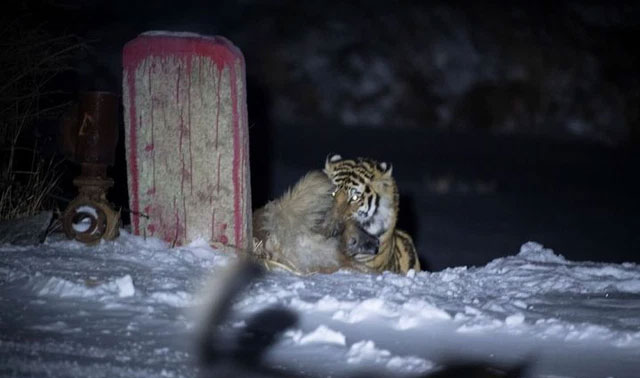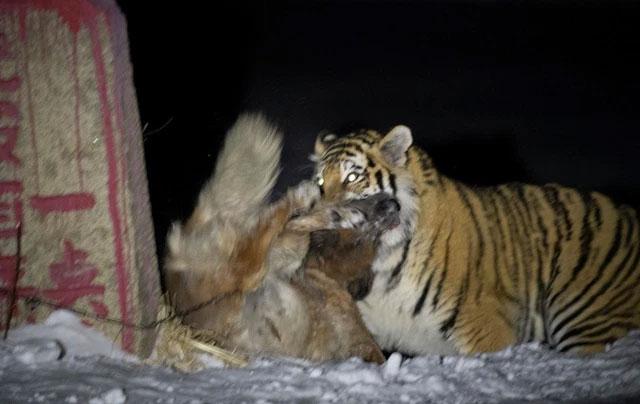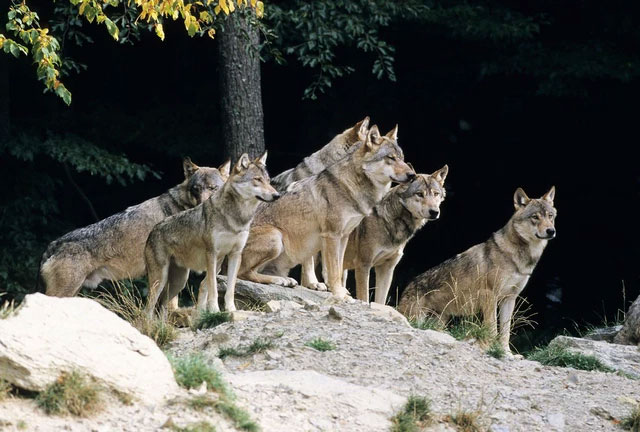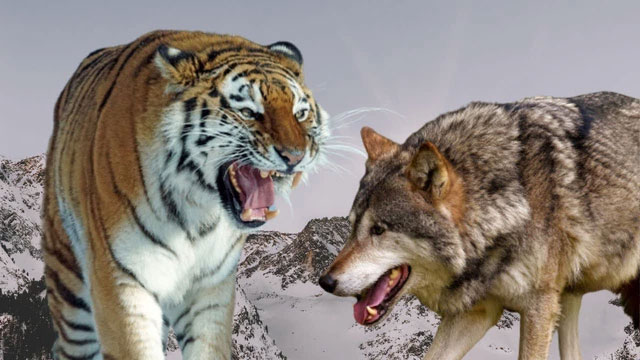It is a fact that tigers have largely disappeared over the past century, making it difficult to find traces of them. However, with the continuous increase in public awareness of wildlife protection and the efforts of many countries, the number of tigers has gradually increased over the years.
This is most clearly demonstrated in China. For example, in February 2021, a Siberian tiger in Jilin broke into villages and killed a large yellow dog belonging to a household, and the entire process was captured by photographers.

Dogs often become the first prey of tigers after they descend from the mountains into the village.
In fact, after reading many such news reports, we will notice a common point: dogs often become the first prey of tigers after they come down from the mountains into the villages.
For instance, around February 2008, seven dogs were killed by Siberian tigers in Jilin; in July 2016, four dogs in a ginseng plantation in Hunchun were eaten by tigers; in October 2019, a dog in Taiping village, Wangqing County, was bitten to death by a tiger.
Historically, China has been considered a “land of tigers”, with tigers living in most of the forests of the country. After the 1950s, “tiger epidemics” broke out in many areas, resulting in a large number of poultry and livestock being killed.
Dogs are more vigilant and harder to catch than animals like chickens, ducks, cattle, and sheep. The main prey of wild tigers is certain hoofed animals. After coming down from the mountains, they also hunt pigs, livestock, sheep, and other domestic animals, but why are dogs always the first species to be killed by tigers?
In fact, tigers enjoy eating dog meat when they come down from the mountains, which is an instinctive reaction embedded in their genes.
Tigers Tend to Hunt Large Animals
Every creature in nature has its own ecological niche. As apex predators, tigers are large and tend to hunt large animals.
The reason is straightforward; an adult Siberian tiger (Amur tiger) can consume 12 kg of meat in one meal. If it eats smaller animals, it needs to eat frequently to meet its daily needs.
Thus, their prey is usually large hoofed animals, and the Amur tiger rarely stalks smaller animals unless prey is relatively scarce.
In a study on the relationship between Amur tigers and wolves in the Sikhote-Alin mountains, it was found that the preferred prey of Amur tigers includes red deer, wild boar, sika deer, and moose, indicating their preference for hunting large hoofed animals.
Accordingly, among domesticated animals, dogs are much larger compared to chickens, ducks, geese, and they are considered medium to large animals that meet the tiger’s size requirements for prey. Additionally, human activities also impact the prey selection of predators. For example, during the early establishment of Gir Forest National Park, the Marhari indigenous people still lived and grazed livestock there.
Their livestock and sheep occupied the habitat of hoofed animals in the forest, leading to Asian lions continuously preying on livestock. It wasn’t until after 1972 that the Marhari people moved out of the reserve, which quickly increased the population of hoofed animals. Upon re-evaluation, it was found that the proportion of livestock in the diet of Asian lions had decreased to 25%.
People conduct agricultural activities around tiger reserves, which to some extent attract certain tiger species. This is because livestock and sheep are easier to catch than wild prey, and crops will also attract some wild herbivores.

Amur tigers need a large amount of food, so they often prioritize hunting large prey.
When Descending from the Mountains, Dogs Are More Likely to Encounter Tigers
Dogs are very loyal animals with a strong instinct to protect their families. Therefore, when tigers descend from the mountains and enter villages, they are often the first to detect the tigers due to their keen sense of hearing and subsequently bark to alert others, inadvertently provoking the tigers and making them chase.
Moreover, although livestock and sheep may satisfy the meat-eating preferences of Siberian tigers, in rural areas where tigers are prevalent, due to prior warnings and damages, people will carefully lock up their livestock and sheep, while dogs are often left to roam freely.

When tigers descend from the mountains into the village, dogs are the first to detect and bark to alert everyone.
According to some documents, dogs were domesticated from gray wolves at the end of the Pleistocene epoch. Despite years of evolution, dogs still resemble gray wolves in appearance, making them recognizable as gray wolves in the eyes of Siberian tigers.
Northeast China and the Russian Far East are areas with relatively well-preserved ecosystems, home to a large number of wild species, including Siberian tigers, gray wolves, Far Eastern leopards, black bears, brown bears, and Eurasian lynxes. However, the competition between wolves and Siberian tigers is the most significant.
Due to the distribution range of Far Eastern leopards mainly being concentrated near the eastern mountain ranges, they avoid the distribution areas of most Amur tigers. Various bear species are omnivorous, resulting in minimal competition with tigers; lynxes are too small, primarily preying on small animals, leaving only gray wolves as a species with prey similar to Siberian tigers, thus creating significant competition between them.

Siberian tigers and gray wolves have almost identical dietary preferences.
Tigers Overpower Gray Wolves, It’s an Instinctive Reaction
Siberian tigers and gray wolves have almost identical dietary preferences, leading to strong mutual competition between the two species based on analyses of feeding habits and other living resources. However, Siberian tigers remain the stronger species.
Researchers have found an inverse correlation between the number of Amur tigers and gray wolves in the Russian Far East.
Before the 20th century, human intervention in nature was not too strong, resulting in a significant number of Amur tigers, while the local gray wolf population was observed to be very rare and remained at a very low level for a long time.

Due to mass killings of Siberian tigers by humans, their numbers decreased sharply.
After entering the 20th century, mass killings of Siberian tigers by humans led to a significant decrease in their numbers, and during the period of tiger decline, the number of gray wolves increased rapidly.
In 1947, Russia declared a strong commitment to protecting Siberian tigers, resulting in a local increase in their population. Additionally, after the 1950s, China began large-scale hunting of tigers, causing a significant number of Siberian tigers to flee to Russia, leading to a rapid increase in the Siberian tiger population in Russia.
During the period of increasing Siberian tiger numbers, the number of gray wolves sharply decreased. Later, thanks to protective measures, the Siberian tiger population stabilized at a higher level, while the number of wolves and their population development were suppressed, stagnated, and even showed a trend of decline.
Therefore, from any perspective, it is not surprising that after tigers come down from the mountains, their first victims are always dogs, especially in the unequal relationship between Siberian tigers and wolves, killing dogs is an instinctive reaction embedded in their genes.


















































